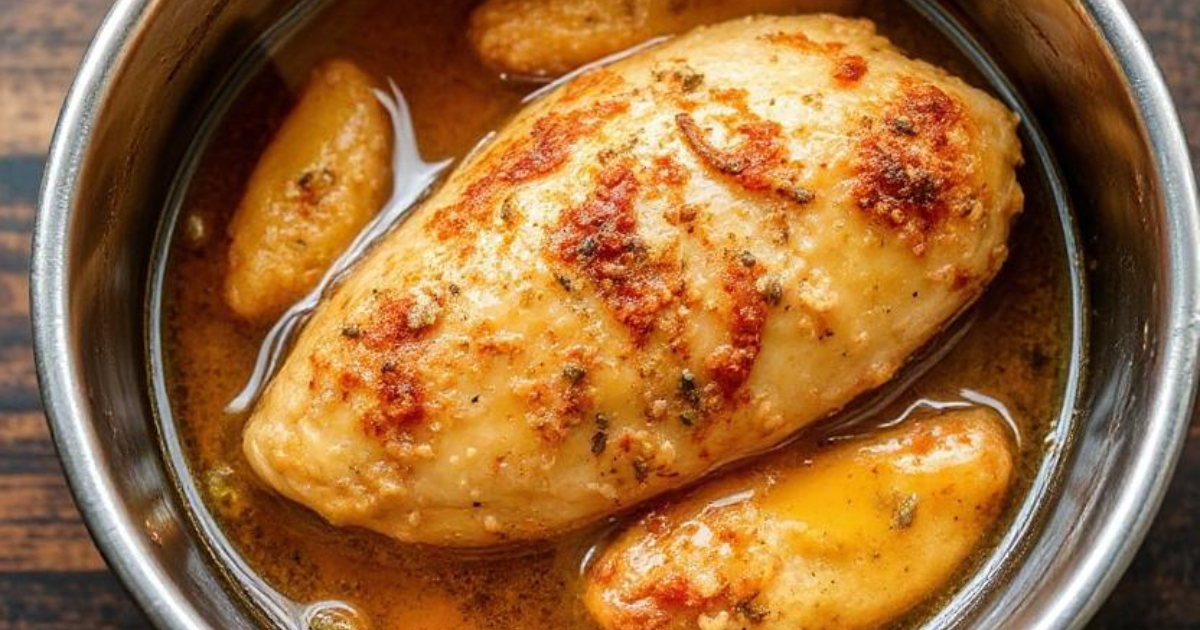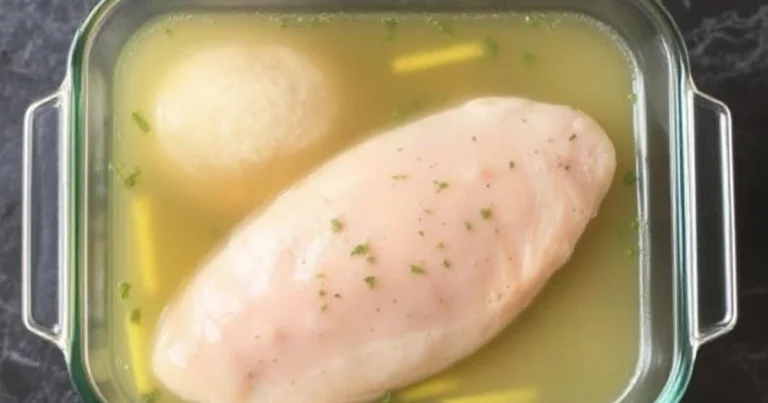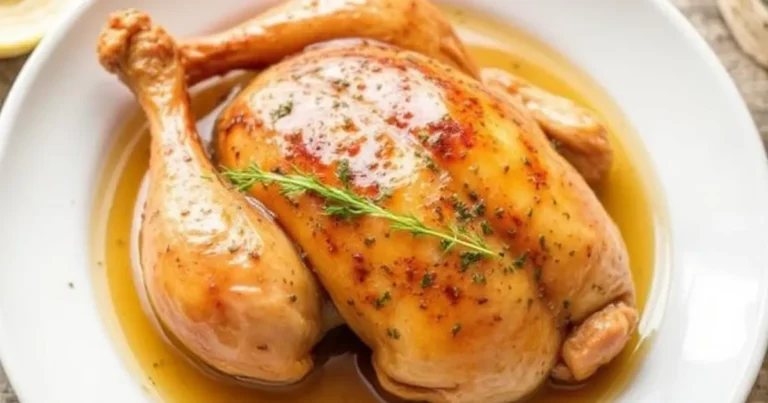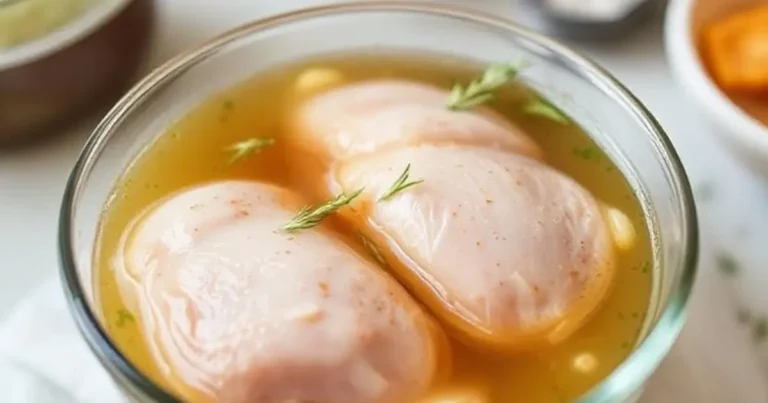Fried Chicken Brine: The Secret to Crispy & Juicy Chicken
Take your fried chicken to the next level with a chicken brine. Both professional chefs and home cooks agree: the right brine is essential. It adds moisture and flavor, making your fried chicken unforgettable.
Learning to brine chicken makes it juicy inside and crispy outside. It’s more than just seasoning. It’s a cooking technique that changes how chicken tastes and cooks.
Anyone can master this technique. With the right chicken brine, you’ll make a meal that wows everyone. It’s a simple way to elevate your cooking.
Table of Contents
Understanding the Magic Behind Chicken Brining
Chicken brine is more than just salt water. It’s a science that turns regular chicken into a juicy, tasty dish. Learning the chemistry behind brining lets you make top-notch fried chicken at home.

The secret of a great brine chicken recipe is in its science. Salt is key, improving chicken’s taste and texture in many ways.
The Science of Salt and Moisture Retention
Salt is the main ingredient in chicken brine. Submerging chicken in saltwater triggers amazing changes:
- Salt breaks down protein structures
- Allows meat to absorb more water molecules
- Creates a protective moisture barrier
How Brining Affects Meat Texture
Brining changes chicken’s molecular makeup. Salt breaks protein bonds, making the meat tender and juicy. This helps it stay moist while cooking.
Chemical Reactions During Brining Process
Now, let’s dive into the cool chemical changes that happen during brining:
| Stage | Chemical Process | Result |
|---|---|---|
| Protein Denaturation | Salt breaks protein bonds | More relaxed meat structure |
| Osmosis | Water moves through cell membranes | Increased moisture retention |
| Flavor Absorption | Salt opens protein channels | Enhanced taste penetration |
By grasping these scientific basics, you’ll take your chicken brine skills to a new level. It’s no longer just cooking; it’s a precise art.
Essential Ingredients for the Perfect Fried Chicken Brine

To make amazing fried chicken brine, you need to know the key ingredients. These ingredients turn regular chicken into a dish that wows everyone. The base of a great brine includes a few important parts that add flavor and keep the chicken juicy.
When you’re learning to brine chicken breast, pay attention to these main ingredients:
- Salt: Salt is the heart of any fried chicken brine. It breaks down proteins and keeps the meat moist.
- Water: Water carries salt and other flavors throughout the brine.
- Sugar: Sugar balances out the salt and helps the chicken brown nicely when fried.
You can also add extra ingredients to make your brine even better. These can add depth and complexity to your dish. Think about adding:
- Fresh herbs like thyme or rosemary
- Aromatic spices such as paprika or cayenne
- Acidic elements like buttermilk or apple cider vinegar
The key to a perfect brine is finding the right balance of ingredients. Too much salt can make the chicken tough. Too little won’t soak into the meat well. Try different mixes to find your own special fried chicken brine that will wow everyone.
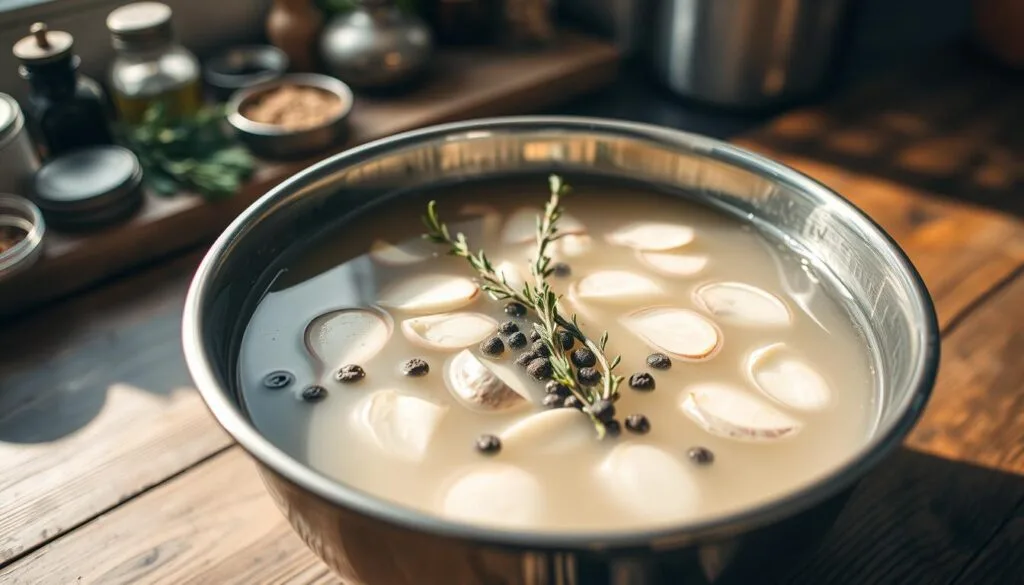
The Ultimate Fried Chicken Brine Recipe
Making the perfect chicken brine is an art. It turns regular fried chicken into a masterpiece. Your brine recipe will make the meat juicy and flavorful, with a crispy outside that wows everyone.
To make an amazing chicken brine, you need to know how salt and liquid work with meat. The right mix can take your fried chicken from good to amazing.
Base Brine Components
The key to a great chicken brine is these basic ingredients:
- Cold water
- Kosher salt
- Sugar (optional but recommended)
Precise Measurement Guidelines
When making your brine, being exact is important. Follow this easy ratio:
- 4 cups water
- 1/4 cup kosher salt
- 2 tablespoons sugar
Optional Flavor Enhancers
Add these exciting extras to your brine:
- Herbs: Rosemary, thyme, sage
- Spices: Black peppercorns, bay leaves
- Aromatics: Garlic cloves, lemon zest
“The secret to incredible fried chicken is in the brine – it’s where the magic begins.” – Professional Chef
A great chicken brine balances flavors and keeps meat moist. Try different mixes to find your favorite.
Step-by-Step Brining Process for Maximum Flavor
Learning to brine chicken breast is all about precision and technique. It turns simple chicken into a juicy, flavorful dish that will wow your taste buds.
Start by picking a non-reactive container big enough to hold your chicken. Glass, ceramic, or food-grade plastic are great for making the brine.
- Make your brine mix with cold water and the right amount of salt
- Make sure the chicken is fully covered in the liquid
- Keep it in the fridge the whole time
The brining time varies based on the chicken’s thickness and cut. Smaller pieces need less time to avoid too much salt.
| Chicken Cut | Brining Time |
|---|---|
| Chicken Breast | 1-2 hours |
| Whole Chicken | 8-12 hours |
| Chicken Thighs | 2-4 hours |
After brining, rinse the chicken well to get rid of extra salt. Dry it with paper towels to help the fried coating stick better.
Pro tip: Always keep chicken refrigerated during brining to prevent bacterial growth.
By following these steps, you’ll make a moist, tasty chicken ready for frying.
Common Mistakes to Avoid When Brining Chicken
Getting your chicken brine right means avoiding big mistakes. These errors can mess up the taste and quality of your meal. Knowing what to watch out for helps you make tasty, moist chicken every time.
Brining chicken might seem easy, but there are several mistakes that can spoil your dish. To brine chicken well, you need to pay close attention and use the right techniques.
Time Management Errors in Chicken Brining
Timing is key when you’re brining chicken. Brining for too long can make the meat too salty. On the other hand, not brining enough means it won’t taste good or be moist.
- Short brining (less than 30 minutes): Minimal flavor absorption
- Excessive brining (over 24 hours): Extremely salty, tough meat
- Ideal brining time: 2-8 hours depending on chicken cut
Temperature Control Challenges
Keeping the right temperature while brining is important for safety. Your brine should always be in the fridge.
| Temperature Range | Safety Status | Recommended Action |
|---|---|---|
| Below 40°F | Safe | Continue brining |
| 40-140°F | Danger Zone | Refrigerate immediately |
| Above 140°F | Unsafe | Discard brine |
Salt Concentration Considerations
Getting the salt just right is crucial in your chicken brine. Too much salt makes the meat taste bad and become tough. Too little salt doesn’t add much flavor.
The secret to perfect brining is precision: measure your ingredients carefully and follow tested recipes.
By steering clear of these common mistakes, you’ll improve your chicken brining skills. This will help you make dishes that are always juicy and delicious, impressing everyone who tries them.
Best Cuts of Chicken for Brining and Frying
Choosing the right chicken cuts is key to a great fried chicken brine. Each part of the chicken affects flavor, texture, and cooking time differently.
When brining chicken breast, knowing each cut’s unique traits is important. Some cuts soak up brine better, making the dish more flavorful and juicy.
- Chicken Breasts: Ideal for fried chicken brine due to their lean meat
- Thighs: Rich in flavor and naturally more tender
- Wings: Perfect for crispy appetizers
- Drumsticks: Great for traditional fried chicken
Each chicken cut needs a specific brining method for the best results. Bone-in cuts keep more moisture and taste richer than boneless ones.
| Chicken Cut | Brining Time | Flavor Absorption |
|---|---|---|
| Chicken Breast | 2-4 hours | Moderate |
| Chicken Thighs | 4-6 hours | High |
| Chicken Wings | 1-3 hours | Low |
| Drumsticks | 3-5 hours | High |
Pro tip: For the best results, choose fresh, high-quality chicken cuts and avoid pre-frozen options when possible. Your choice of cut will directly impact the final taste and texture of your fried chicken.
From Brine to Fry: Perfect Cooking Techniques
To turn your fried chicken brine into a tasty meal, you need to be precise and skilled. First, brine your chicken carefully. Then, you must master several key techniques to get that crispy outside and juicy inside.
Drying Methods After Brining
Getting the chicken dry is key for a crispy fried chicken. Your smoked chicken brine needs careful attention to dryness. Here are some drying methods to try:
- Pat chicken thoroughly with paper towels
- Use a wire rack to air-dry for 30 minutes
- Refrigerate uncovered for optimal moisture reduction
Coating Techniques
The right coating can make your fried chicken brine recipe amazing. Here are some coating methods to consider:
- Classic flour dredging
- Buttermilk and seasoned flour combo
- Cornstarch for extra crispiness
| Coating Method | Texture | Flavor Profile |
|---|---|---|
| Flour Dredge | Light and Crisp | Neutral |
| Buttermilk Coating | Thick and Crunchy | Tangy |
| Cornstarch Mix | Extra Crispy | Neutral with Crunch |
Oil Temperature Control
Keeping the oil at the right temperature is vital for perfect fried chicken. Use a deep-fry thermometer to keep the oil between 325-350°F. This ensures your chicken cooks evenly without burning the outside.
Pro Tip: Consistent oil temperature is the secret to achieving golden-brown, crispy chicken every time.
Flavor Variations for Your Brined Fried Chicken
Exploring new flavors can turn your fried chicken into a culinary adventure. Try adding regional and international twists to your brine. This can make your dish a true taste sensation.
Different brine recipes offer unique tastes. Southern-style brines offer traditional comfort. Meanwhile, global inspirations add a thrilling twist to your cooking.
- Southern Buttermilk Brine: Tangy and rich, perfect for classic comfort food
- Asian-Inspired Soy Ginger Brine: Adds depth and complexity to fried chicken
- Herb-Infused Mediterranean Brine: Brings fresh, aromatic notes to your dish
Creating the perfect brine chicken recipe is all about flavor balance. Think about how different ingredients work together. Here are some flavor combinations to try:
| Flavor Profile | Key Ingredients | Recommended Pairing |
|---|---|---|
| Spicy Cajun | Cayenne, paprika, garlic | Coleslaw, cornbread |
| Herb Provence | Thyme, rosemary, lavender | Roasted vegetables, green salad |
| Korean-Inspired | Gochujang, soy sauce, sesame | Kimchi, steamed rice |
Try these flavor variations to find your own special chicken brine. Each one offers a unique culinary journey. It’s sure to impress your family and guests.
Storage Tips and Reheating Brined Fried Chicken
After you’ve mastered the fried chicken brine, it’s key to know how to store and reheat it. Proper storage keeps your brined chicken tasty and safe for days.
Smart Storage Strategies
Here are the must-follows for storing brined fried chicken:
- Cool the chicken completely before storing
- Use airtight containers or sealed plastic bags
- Refrigerate within two hours of cooking
- Store in the refrigerator for up to 3-4 days
Reheating Without Losing Crispiness
Reheating brined chicken needs a special touch to keep it crispy. Avoid microwaves, as they can make it soggy.
- Preheat oven to 375°F
- Place chicken on a wire rack over a baking sheet
- Warm for 10-15 minutes until internal temperature reaches 165°F
- Optional: Brush lightly with oil to restore crispiness
An air fryer is great for reheating brined chicken. It heats evenly and keeps the chicken crunchy. Choose your method, and your fried chicken will always be delicious.
Conclusion
Crafting the perfect fried chicken begins with understanding chicken brine’s power. By learning about brining, you’ve discovered a secret that makes chicken amazing. This journey shows how brine can boost your cooking skills.
Now, you can try new ingredients and methods in your fried chicken. Whether you’re making classic Southern-style or bold flavors, brining is key. Remember, the more you practice, the better you’ll get.
Home cooks can now match professional chefs with brining techniques. It takes patience, detail, and a desire to learn. You’ll learn to pick the best chicken and use just the right amount of salt. Start now, be creative, and watch your cooking skills grow.
With chicken brine knowledge, you’re set to make meals unforgettable. Your friends and family will love the juicy, crispy fried chicken from your kitchen. Keep trying new things and enjoy the journey of improving your fried chicken skills.
FAQ
What is chicken brining and why is it important?
Chicken brining means soaking chicken in a saltwater solution. This helps the meat stay moist and flavorful. It’s key for juicy, tender chicken, especially when frying.
How long should I brine chicken for the best results?
Brining time varies by chicken cut. Breasts need 30 minutes to 2 hours. Whole chickens can brine for 4-8 hours. Avoid over-brining to prevent too much salt and texture changes.
Can I use kosher salt or table salt for brining?
Use kosher salt for its larger crystals and pure taste. Table salt should be halved due to its density. Sea salt is also a great brining option.
Is it safe to brine chicken at room temperature?
No, brine chicken in the fridge to avoid bacterial growth. Food safety is critical. Keep the chicken at or below 40°F (4°C) to ensure it’s safe to eat.
Can I add other flavors to my chicken brine?
Yes! Add herbs, spices, garlic, citrus zest, or sugar to your brine. These enhance flavor and help keep the chicken moist.
How does brining affect different cuts of chicken?
Brining affects chicken cuts differently. Breasts benefit most as they dry out easily. Thighs and drumsticks need less brining due to their fat. Bone-in cuts retain more flavor.
What’s the difference between wet and dry brining?
Wet brining soaks chicken in liquid, while dry brining uses salt rub. Wet brining adds moisture. Dry brining enhances natural flavors and crisps the skin.
Can I use the same brine for different cooking methods?
Basic brine principles are the same, but adjust for cooking methods. Brines for fried, smoked, or roasted chicken may differ based on flavors and techniques.
How do I know if I’ve over-brined my chicken?
Over-brining shows in salty taste, mushy texture, and translucent meat. If it tastes too salty, you’ve brined it too long or used too much salt.
Can I reuse a chicken brine?
No, never reuse chicken brine. It can contain harmful bacteria. Always make a fresh batch for each use to ensure safety.

